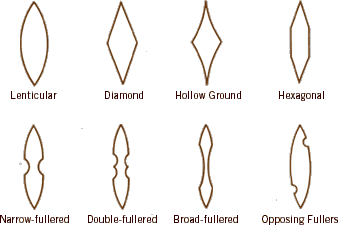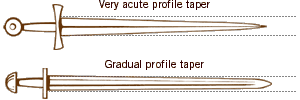- 积分
- -65
注册时间2011-1-28
参与分
技术分
精华
该用户从未签到
|
勉强看 翻印难 转过来 等高人翻译。
Understanding Blade Properties
An article by Patrick Kelly
Introduction
Here we will discuss the basic properties of a sword blade. These terms and definitions refer mainly to blades of the Viking age through the renaissance period. Blades of the earlier Bronze Age, as well as the post reformation/colonial period, exhibit unique attributes that may fall outside the scope of these terms. These terms and definitions are not offered as an absolute in sword design. Any experienced collector or historian will freely admit that there are always exceptions to every rule. In the virtual cornucopia that is sword design it is a dangerous thing to make absolute statements. These definitions are offered as a guideline for the beginning sword collector and martial artist. The old adage "The more I know the less I'm sure about" is a good thing to remember.
Blade Manufacture
The common view of the medieval swordsmith is that of a single artisan working alone at a forge, ** a sword from start to finish. While this may indeed have occurred, it was far from the norm. Medieval blades were made in a far more "modern" fashion than is commonly believed. They were often forged in blade-** centers then exported to different locales and hilted by local cutlers in the latest fashion. Antique blades that bare the mark "Ulfberht" are an excellent example. There are far too many blades that have this mark to have been made by a single man. Ulfberht was obviously the Smith & Wesson of its time.
Modern swords are made by two different methods: forging and stock removal.
Forging is recognized as the traditional method utilizing hammer and anvil. The hot blade is hammered to shape and then finished by grinding and polishing. While this is the traditional method it is more time consuming and, as a result, more expensive.
Stock removal is the process where a blade is manufactured by using a billet of steel that is ground to shape and then polished. While forging is undoubtedly the more traditional approach, it does not result in a superior blade simply because of this process. The method of heat-treating is far more important in determining the blades end quality.
The blade gains its hardness by heat-treating. It is then tempered by being heated a final time and allowed to air cool. This allows it to remain hard enough to hold an edge yet tough enough to absorb punishment. Heat-treating and tempering are often two aspects of blade ** that are confused.
Blades may be made utilizing differential heat-treating—a process that results in a harder edge and a softer body. This allows for greater edge retention while maintaining proper shock absorbance. Most modern-made replicas will use a process know as through hardening in which the heat-treating process maintains the same hardness throughout the blade, resulting in a blade that is tough and serviceable yet is also more affordable for the customer.
Medieval illustrations also show the use of large millstones being used in the grinding process. The modern act of stock removal may not be as far from the historical norm as previously thought. Both processes can produce a blade that is fully functional and well made.
In terms of performance there is no difference between forging and stock removal. Still, there are many modern bladesmiths who make their wares using hammer and anvil in the time-honored tradition. While their swords may be more expensive, they are in high demand. There are many modern-day collectors and martial artists who insist upon a forged blade for the sake of art and historical connection.
Blade Geometry
When we use the above term we are referring to the sword's basic statistics: cross-section, blade width, thickness, taper, etc. When measuring a sword's specifications it is best to use a set of calipers in order to get as accurate a measurement as possible. Fractions of an inch can drastically alter the dynamic properties of a sword blade. This is important to keep in mind especially when commissioning a smith to recreate an existing historical piece. A difference of an eighth or sixteenth of an inch here or there can result in a far different sword than the customer desires.
Cross-section
 A blade's cross-section varied widely over the span of the sword's use as a primary weapon. Simply put, if you were to cut a blade in half crosswise and then look at its cut end you would see the blade's cross-sectional design. A blade's cross-section varied widely over the span of the sword's use as a primary weapon. Simply put, if you were to cut a blade in half crosswise and then look at its cut end you would see the blade's cross-sectional design.
Early Viking and medieval European blades tended to have a lenticular cross-section. This is primarily a lozenge or apple seed type of design that lacks a strong central ridge in the middle of the blade. When coupled with a wide shallow fuller this resulted in a blade that was both light and flexible. While blades of this period were capable of thrusting techniques their main focus was on the cut so flexibility was preferred over rigidity.
As armour improved over the span of the middle ages blades exhibiting a diamond cross-section became more common. This consists of four flat faces that are joined to form a diamond with the blade's central ridge forming the inner juncture and the edges forming the outer. The diamond cross-section could still be broad and flat when used in a cutting blade; however, this blade would exhibit more rigidity than the earlier lenticular design and as such would be more effective in thrusting techniques. Swords of dedicated thrusting designs could be of a more acute diamond cross-section and while lacking the mass of a cutting blade would be quite ridged and efficient in the thrust.
Blades of hexagonal cross-section were also found side by side with these other two designs. A hexagonal cross-section simply consists of a blade with six faces. Two broad (or narrow depending on type) faces that make up the flat of the blade and four smaller angled faces that form the edge. Blades of diamond cross-section can often be found with a hollow ground design. This results in a blade that is light and very ridged, ** it very effective in the thrust. Blades of diamond and hexagonal design can also be seen with both broad and narrow fuller(s). These were used to lighten the blade while not sacrificing integrity and also simply to add visual detail to the blade.
A note on the term "fuller": The fuller is the channel, or groove, found on a sword blade. A fuller can be broad or narrow, shallow or deep, depending upon the sword's design and intended mission. It is often erroneously referred to as a "blood groove" or "blood channel". In fact, the fuller has nothing to do with any kind of bodily fluids but is intended to lighten the blade without weakening it.
Taper
 A sword blade tapers in two different areas: distally and in profile. Distal taper refers to the thickness of the blade. It will usually be observed that thickness lessens from the base out towards the tip. This is done in order to maintain handling and mechanical characteristics. A cheap modern reproduction will usually have no distal taper and will seem overly heavy and "dead" when compared to a quality reproduction of the same design which does exhibit distal taper. A sword blade tapers in two different areas: distally and in profile. Distal taper refers to the thickness of the blade. It will usually be observed that thickness lessens from the base out towards the tip. This is done in order to maintain handling and mechanical characteristics. A cheap modern reproduction will usually have no distal taper and will seem overly heavy and "dead" when compared to a quality reproduction of the same design which does exhibit distal taper.
Distal taper will often be continuous from the blade's shoulder to the point, but not always. In order to maintain a good mix of mass and balance, a blade may taper in increments or may taper in only the later half of its length. When dealing with historical designs it is important to keep the sword's intended mission in mind and to realize how the maker fashioned the blade in order to meet that mission.
 Profile taper is the degree of tapering along the flat of the sword, i.e. a measure of the blade's width along its length. An earlier medieval blade such as Oakeshott's Type X will have little profile taper as it was meant primarily to be a cutting instrument whereas a blade of Oakeshott's Type XII will exhibit increased profile taper since it was designed to be a cutting blade with improved thrusting capability. Profile taper may be continuous or may be more gradual, leaving the blade with a bit of a "belly". Once again, this depends upon the weapon's intended purpose. Profile taper is the degree of tapering along the flat of the sword, i.e. a measure of the blade's width along its length. An earlier medieval blade such as Oakeshott's Type X will have little profile taper as it was meant primarily to be a cutting instrument whereas a blade of Oakeshott's Type XII will exhibit increased profile taper since it was designed to be a cutting blade with improved thrusting capability. Profile taper may be continuous or may be more gradual, leaving the blade with a bit of a "belly". Once again, this depends upon the weapon's intended purpose.
Point of Balance
The PoB is simply the sword's center of gravity. This can easily be found by balancing the sword, lengthwise, upon your finger. The point of balance will vary widely from type to type. An early medieval cutting sword will not balance the same as an 18th century smallsword. Many beginning sword collectors will put excessive emphasis on the sword's point of balance. Statements to the effect of "my swords have to have a PoB four inches from the guard" will often be heard from a novice. If the aforementioned medieval cutting sword has a PoB two inches below the guard, it probably won't be an efficient performer regardless of how "alive" it may feel to the owner. Likewise, that smallsword shouldn't have a PoB eight inches from the guard.
A sword's point of balance is only one small piece of the complex puzzle that makes up a sword. Instead of asking ourselves if the sword feels "good" in terms of our personal wishes we should instead ask if the sword feels "proper" in accordance with its intended purpose. |
|